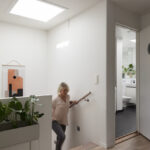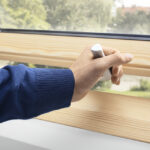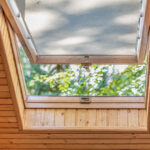Are you noticing in the colder months that your roof windows have a re-occurring mist? Or maybe the interior glass pane or window frames are beginning to look a bit foggy? If so, this article was made for you! We’ll be going into detail on condensation on VELUX roof windows, and methods you can implement to prevent a large build up this winter – so let’s get straight into it!
What is condensation?
Condensation is the conversion of vapour to liquid. It occurs when the air becomes saturated with moisture and reverts to a liquid state. It’s a wet mist that sometimes clouds the interior glass on your roof windows.
It occurs more often during cooler weather because a greater temperature difference exists between the warm interior of your home and the colder outdoor temperature.
Warm air carries larger amounts of water than cold air; so when this moisture-laden indoor air contacts a cooler surface such as a windowpane, condensation forms on that surface.
What causes condensation to occur in windows?
The air around us contains water vapor (humidity). We add to it by normal breathing, perspiration, cooking, cleaning, and showering. These added elements are the main culprits of an increase in condensation.
Condensation can form not only on the surface of the window, but also between the glass panes. This could be an indication of a greater issue with your VELUX window.
How can I tell if I have condensation? (What to look out for)
If you notice any of the following issues in your house, this may mean you are experiencing condensation:
- Water collecting on the inside of windows or on the windowsill.
- Water collecting on non-absorbent surfaces like tiles/mirrors.
- Black mould growth on walls and skirting boards.
- Rotting and peeling of wallpaper.
- Mould growing on clothes and other fabrics.
- A strong musty smell.
Signs of long-term damage
You may notice that if you have had a long-term battle with condensation, your windows could already be showing the following signs:
- Timber framed roof windows – The lacquer coat is peeling away from the frame, or the window is starting to swell.
- Polyurethane roof windows – Black mould is forming on or around the window frame.
How can you prevent window condensation?
Condensation is a moisture problem; to manage it you need to limit the amount of water vapour in your home.
Below are some ways you can start eliminating sources that contribute to excess humidity:
1) Regular maintenance for your VELUX roof windows
VELUX advise that roof windows are serviced at least once a year in line with their warranty. This should be enough for you to enjoy all the benefits a roof window offers without having to worry about unpleasant surprises like condensation or leaking.
2) Regularly ventilate your rooms by using the window’s vent position
We sometimes find our customers have no idea that their VELUX roof windows come equipped with vents for this very reason. All it takes is for you to open them up to let some of that excess moisture out of your home
3) Use of extractor fans
Alongside opening any windows in rooms with higher humidity like kitchens and bathrooms, we would also recommend installing/making use of an extractor fan.
4) Open your curtains and blinds
Leaving your windows covered for a long period can create a kind of microclimate, encouraging condensation to form. Opening blinds and curtains can reduce the chances of this by letting the air reach your windows.
5) Control the temperature throughout the house
Ensuring an adequate amount of heating in your property will improve the internal temperature of surfaces in the house and reduce the likelihood of condensation.
6) Run a dehumidifier during the winter months and damp weather
When your home is maintaining excess moisture, investing in some dehumidifiers can be a worthwhile investment. These traps help to reduce the levels of moisture in the air and ultimately keep window condensation to a minimum.
In summary
It is important to note that you cannot stop all sources of moisture coming into your home, but you can take the necessary steps to ventilate it. Your home needs to breathe to fight condensation build up.
Remember – cold air holds less water vapor than warm air. In the winter, the air outside is often drier than the humid air in your home. By allowing moist inside air to escape and dry outdoor air to enter, you can balance your home’s humidity level.
Of course, if they are looking a bit worse for wear you may want to think about replacing your roof window.
If you need any assistance, advice, or a quote for a service or replacement, please do give our friendly team a call on 0800 195 0591, option 1 and we can investigate the best solution for you!






















